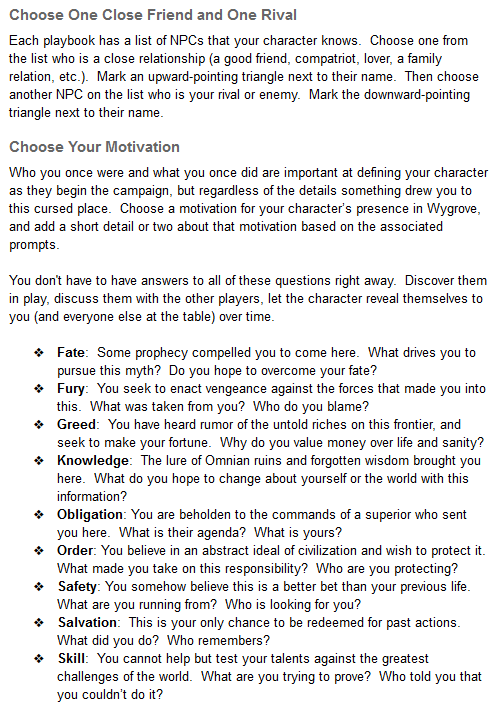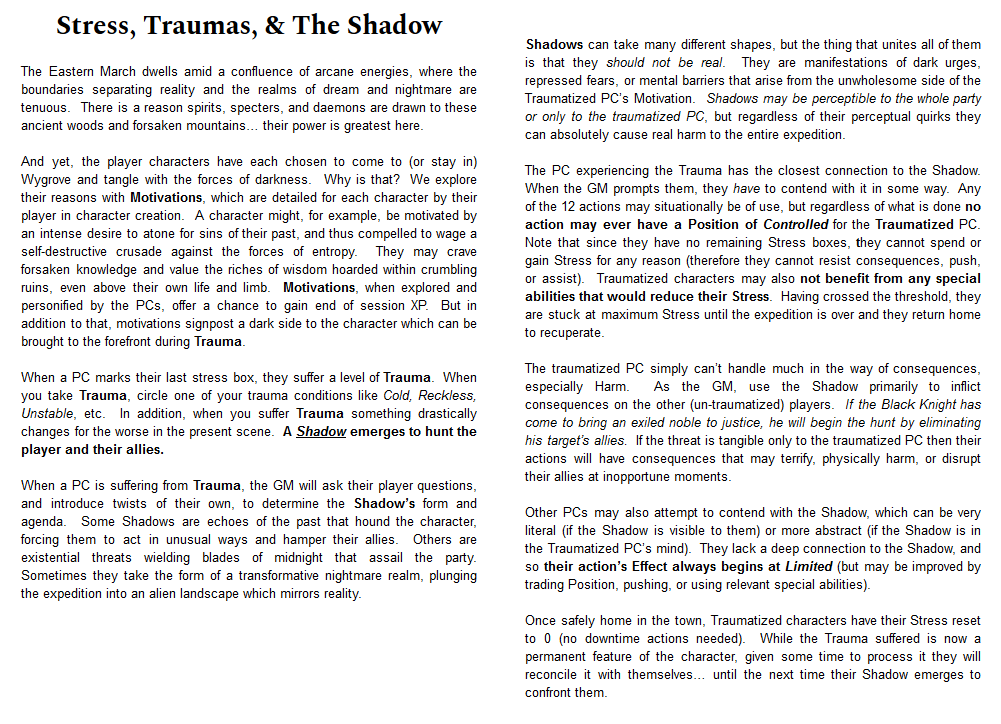#AgeOfBlood
Following on from the discussion associated with Sean Nittner’s post on game design thoughts, I thought I’d do a preview today of Motivations and Trauma in Age of Blood.
This one has twisted about in various ways since initial conception and it’s not fully settled yet. BitD has the scoundrels (and the majority of NPCs) effectively trapped in Duskwall, so that there’s no hanging question of “what if it makes more sense for my PC to just leave” when things get tough for the crew. It also drives the concept of Vices to cope with the nature of the setting. This is excellent in many ways for the design of BitD but doesn’t exactly work if you don’t have Lightning Barriers in your setting and want the PCs to travel overland to various places on Expeditions (the replacement for Scores in AoB). I decided to throw out Vices and Indulgence to focus the design elsewhere in Age of Blood, and I needed a replacement (in a large part because Vices can be a big XP trigger and help you define your character).
So instead each PC has to be there for a compelling personal reason, a Motivation. As Sean alludes to in his twitter thread, the challenge in a setting that resembles a classic fantasy dungeon-delver is having motivations that make sense and don’t just turn the players into the classic “Murder-Hobo” trope, killing anything that moves and looting whatever is not bolted down. That is narratively troubling and unsatisfying thematically (it’s quite flat at the end of the day). But players should be able to play characters who have flaws, right? They should be allowed to be a bit greedy, a bit damaged, a bit haunted. How to represent that?
I went with the concept of a Shadow Archetype. Every PC has one, and they are a concept that can evolve during a season of play. Shadows are really malleable right now but basically they are what happens when a PC Traumas during either Expedition or Freeplay. Rather than have that PC be removed from the scene as in Blades, a Shadow is a manifestation of the darker side of a character’s motivation who drives a fearsome new threat the whole party needs to find answers for.
I am going to develop a list of possibilities with options for each Motivation (and some paired Traumas that make sense), but they can range from spectral shades assailing the party to “Dark World” mirror landscapes one or all players become trapped in, baleful artifacts or daemons that whisper compelling temptations to the traumatized PC or their allies, and psychological horrors only the afflicted PC can see but which damage their allies around them. Because of the flexibility of action, consequence and harm in Forged in the Dark, you can easily imagine a lot of “Shadow” scenarios which differ wildly in the fiction but add up to a similar feel mechanically.
To borrow Lord of the Rings terminology: Shadows are not bands of Orcs, Saruman, or Sauron (factions or persistent characters that act in the world and exist independently of the PCs). Shadows are the Ringwraiths, particularly in Book 1 and 2, as well as the Ring itself, specifically how it acts through the minds of the bearer and jealous allies. Gollum is a Shadow, representing a repressed desire for power and a potential dark future that must be resisted by Frodo. They are ineffable foes who lurk on the margins and manifest at moments of critical weakness (represented by a Trauma).
Mechanically they need to be nailed down a bit more. Are they a clock that can be eventually worn down, or do they just persist all the way to the end of the Expedition/Score? How often should a Traumatized PC be pressed to act relative to their allies, who may still be dealing with the tangible threats remaining in the Score? Experimentation in playtesting has the answer to these questions, because I don’t know yet.
Does having Motivations tied to Shadows that the PCs must struggle with solve the inherent questions of the setting WRT colonialist narratives (“the murder-hobo problem”) and players having to justify their PCs not running away from the town when the going gets tough? Maybe not fully, but I believe that it will help drive more emergent storytelling and explorations of character at the table. Having multi-faceted characters and compelling storylines for them is one antidote to keep them from being power-fantasy player avatars, in my opinion.
I was hoping to have session “0.5” (crew playbook, character introductions, perhaps some free play to establish the starting scenario and setting) of my first playtest this Tuesday on roll20, but one of my players who lives in the (U.S.) north-east got ferociously snowed in and has lost internet. Trying again next week!



One question that I hope playtesting will answer: Are Traumas even necessary anymore, or are they just a vestigial leftover that should be merged completely into Shadows? In theory-crafting scenarios where a PC traumas, do you really want to jump through the conceptual hoop of figuring out which Trauma best personifies the threat that has emerged? Or just focus on the Shadow?
“[Mark XP] When you struggled with issues from your Corruption or Shadows.”
Hmm, I suppose I could get behind that sentence. As you can see this is a pretty new idea I’ve latched onto and am still mentally iterating on.
Trauma and Shadow don’t seem like they should be linked like this. The examples of Shadow given are actual threats – and yet it says they should not be real. The ringwraiths and Gollum were quite real, and not just to Frodo. These were threats, i.e. the source of consequences that an action roll might avoid, not personal demons.
Any manifestations of Trauma should remain in the players hands imho
Mark Cleveland Massengale You’re correct, I’m conflating the literary terms a little. But looking at Lord of the Rings not from the perspective of story audience and instead a GM-style directorial viewpoint that considers primarily the viewpoint of “the players,” I think that it’s a totally reasonable argument that the Ringwraiths and Gollum exist for the sake of the Protagonists. Their introduction to (what would be the viewpoint of) the PCs of LotR occurs specifically at moments of highest tension or deepest despair and they principally act on those PCs to raise the stakes or personify temptations/character flaws.
As far as Traumas go, even just a little bit of brainstorming with my players has me thinking Traumas possibly just go away in this hack to make room.
I should also add that the terminology about what a Shadow is, is all first-draft placeholder text. I already think I need to expand it to potentially include flesh-and-blood Rivals who are closely linked to a character’s background (the Inquisitor hunting a PC Cultist, or the vampire who taunts a PC monster slayer). Another way to go for certain characters could be to treat a Shadow as entirely mental (real only to the character perceiving it) sort of like the “Affliction” model from Darkest Dungeon.
The necessary element to me is that of the recurring adversary/situation that is closely linked to a PC’s repressed character traits. By definition it is something that approaches a party when someone has hit maximum Stress and thus conveniently embodies the compromised mental ability of “the protagonist” to react against their embodied inner demon(s).
Whether I can successfully pull all those things together under the same umbrella remains to be seen. The real important thing about the idea to me is finding a mechanical lever that ties the literary idea of the Shadow in with player motivations and a heightening of tension in the (rare) moments of hitting maximum stress in-game.
I’m working on reskinning S&V for submarines. One think I was thinking about changing was “Overindulge in your Vice, and are gone for next session.” That doesn’t really work when the story spends most of it’s time in a submarine. I like your idea of Shadow Archetypes, it reminds me of being in Iraq when I was in the US Army. People would get really angry, depressed, or something for a few days, and we just had to deal with it. They won’t gone, they still did missions with us, and we all went through it over the 13-18 month tour.
Charles Simon Mechanically, traumas provide at least 4 functions. A mechanic to reinforce character flaws that arise from living a life of crime, a mechanism to provide a “game over” besides death, an opportunity to add depth to role playing, and a way to reward roleplaying (through xp). In your hack, what do you lose by eliminating trauma? Shadow Archetype replaces the consequences that a trauma represents. It also provides the ability for roleplay and reward through xp. So, the only missing piece is a defined “game over.”
Does that matter in your fiction? Do you need to have that accounting measure at all? If so, could it be replaced in a more streamlined manner? One thought experiment is to just say that after 4 shadow archetype introductions, the character needs to retire. How does that impact your concept of the stories that you want your game to tell?
Charles Simon I’m rambling now… I am going through the same process with my “blades in the brokenlands” fantasy hack. high fantasy is much less gritty than blades in the dark, so heat & wanted just didn’t seem to fit. I ditched it and just used rep & tier. However, entanglements are important to an ongoing story, so I had to find a high fantasy replacement — I went with “larger than life” a way to introduce the fun (and entanglements) of becoming famous.
Eric Brunsell Yeah good points. Right now mechanically (until playtesting tells me I need to think otherwise) I’ll leave it at “Retire at 4” where the player gets a narrative option to describe their PC closing the loop on their Shadow in some way. This might be a heroic death, merging with their dark side and laying down the sword, or something else in between. Then we go into the Stash chart and figure out what their retirement looks like, which is something I wanted to give some nice incentives for (see attached).
If the player chooses a less merciful narrative fate for their character then the chart should still work with some adjustments, I feel. Probably need to edit it appropriately to make that clear.
https://lh3.googleusercontent.com/m5oKuwKMOgSCO351LsIJ9VmnCns2cL_BJRSEStZ_1GYteciJxAjOTn2OEywn8g9O-IGb61rxz5eHl6-iSEsJSsRewdqDcid9o1M=s0
Charles Simon that looks great! I think you could easily make a dark side to the stash list – if the shadow “wins” the player and GM negotiates how the retired character takes an evil path to thwart the town…
I like the aftermath stuff. I do that for my playtesters, but making it a thing in the rules seems cool too
It’s cool to see how some posts drive development ^_^